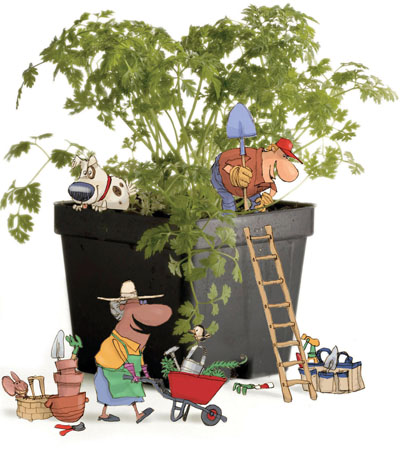
Spending time outside yields a bushel of health benefits, including exposure to fresh air and sunlight (the best source around for vitamin D), as well as all the mental and emotional bonuses that derive from communing with nature.
C’MON GET HAPPY! Spending time outside yields a bushel of health benefits, including exposure to fresh air and sunlight (the best source around for vitamin D), as well as all the mental and emotional bonuses that derive from communing with nature.
“Studies indicate that children are happier, healthier, smarter and more self-disciplined when they have regular opportunities to be outdoors,” says Cheryl Charles, president and CEO of the Children & Nature Network.
And gardening, she notes, encourages qualities such as empathy and close observation.
If you don’t have room for a full-size garden, try growing veggies in space-saving containers.
GET SOME EXERCISE
Gardening tasks provide plenty of exercise, from digging, to hoeing, to toting water. The only tough part can be convincing your kids to pitch in. Inspire your little helpers by turning garden work into play.
– Make planting fun with a seeding straw: At one end of a plastic drinking straw, mark eight -inch intervals with a permanent marker. To plant, stick the straw in the soil to the required depth, drop in a seed, remove the straw, and cover the seed with soil. (For large seeds, use a wide straw designed for bubble tea.)
– Challenge your kids to a weeding contest: Have each child pick one type of weed and start pulling on the count of three. Then see who’s collected the most when the allotted time (say, 15 minutes) is up.
A tasty collection
Even selective eaters find it hard to resist the fun of nibbling something straight off the plant. Tempt them with these pick-and-eat favorites:
– Cherry tomatoes:Who knew getting your vitamin C could be so tasty? We like Sun Gold for its sunny orange color, sweet-tart flavor and high yield.
– Green beans: The king of crunch. Build tepees out of wood or bamboo stakes (as tall as you can reach) and let pole beans scramble to the top.
– Strawberries: Try one of the alpine varieties that bloom all season long. They’re kinda cute: smaller than the types you’ll find in the supermarket but sweeter.
Learn something new
A garden is like a classroom without all the desks, grades and homework. It presents endless opportunities for hands-on environmental learning. These subjects have built-in kid appeal:
– Beneficial bugs: For a lesson that’ll keep your kids buzzing, teach them about helpful bugs (and other creepy-crawlies) that aerate soil, pollinate crops and dine on pests. You can find an A-Z list of insect facts and sites at home schooling. gomilpitas.com/ explore/bugs.htm.
– Composting: Show your kids the magic of turning garbage (the organic kind, that is) into super-healthy soil food. For detailed tips, go to journeytoforever.org and click on “composting.”
– Photosynthesis: To learn how plants make food from light, check out the video at newtonsapple.tv/video. php?id=915. Then look in your own garden to see how plants are reaching for the sun.
Memory improvement
A study in the journal Evolutionary Psychology found just receiving flowers made people feel better – and helped improve memory. For the sheer fun of it, try growing:
– Mammoth sunflowers: What’s not to love about a flower that’s taller than Mom and Dad?
– Morning glories: This old-fashioned favorite couldn’t be prettier. For a touch of whimsy, train the vines over a colorfully painted old chair. Get directions at FamilyFun.com (search “Fairy Chair”).
– Nasturtiums: Both the colorful blooms and nifty lily pad–shaped leaves are edible. Toss them in your salad for a peppery bite.
– Lavender: It’s long been a favorite for its fragrance, which folk wisdom holds can fight stress and aid sleep. To make a sachet, cut a dozen stems above the leaves as the buds color and start to open, hang them upside down for 7 to 10 days to dry, then remove the buds. Place the buds in a child’s cotton sock, and tie it closed with ribbon.
super nutrients
Most fresh produce offers nutrients, but some vegetables are more high-powered than others. When choosing your crops this spring, pick these favorites, which are both kid-friendly and super-nutritious:
– Carrots: They’re high in vitamin A, fiber and carotenoids – powerful antioxidants that boost your immune system. For fun, plant the cute, round variety called Thumbelina: small in size but big in flavor (and great for heavy soil or containers).
– Tomatoes: One medium tomato delivers a healthy dose of vitamins C and A. Make a hanging tomato planter (get directions at FamilyFun.com) saves space – and weeding.
– Bell peppers: Buy them at the store, and you could be bringing home pesticide residue (peppers are No. 3 on the Environmental Working Group’s “Dirty Dozen” list of fruits and vegetables). Grow them yourself organically, and all you’ll be getting is vitamin C, a ton of phytonutrients and great taste.









